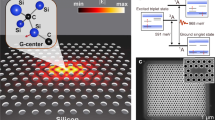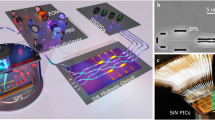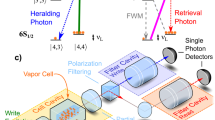Abstract
Optical buffer memories, which do not rely on an intermediate conversion between optical and electrical signals, can be used to realize optical networks with low latency and low energy consumption. Photonic-crystal nanocavities can confine photons in a very small region for a long time, and thus may be used as core components of such optical buffer memories. However, a scalable method for on-demand photon transfer between nanocavities is required. Here we demonstrate a photonics–electronics integration solution that realizes electrical control of a coupled ultrahigh-quality-factor nanocavity system on a silicon chip. In this system, the photons confined in one of the two storage nanocavities can be transferred to the other storage nanocavity by applying a voltage pulse to the control cavity. A transfer efficiency of 76% and a cavity photon lifetime of 1.3 ns after the transfer are achieved.
This is a preview of subscription content, access via your institution
Access options
Access Nature and 54 other Nature Portfolio journals
Get Nature+, our best-value online-access subscription
$29.99 / 30 days
cancel any time
Subscribe to this journal
Receive 12 print issues and online access
$209.00 per year
only $17.42 per issue
Buy this article
- Purchase on Springer Link
- Instant access to full article PDF
Prices may be subject to local taxes which are calculated during checkout




Similar content being viewed by others
Data availability
All the data supporting the findings of this study are available within this Article and its Supplementary Information, and are also available from the corresponding author upon reasonable request.
Code availability
All associated codes for simulations are available from the corresponding author upon reasonable request.
References
Noda, S. Recent progresses and future prospects of two- and three-dimensional photonic crystals. J. Lightwave Technol. 24, 4554–4567 (2006).
Baba, T. Slow light in photonic crystals. Nat. Photon. 2, 465–473 (2008).
Reed, G. T., Mashanovich, G., Gardes, F. Y. & Thomson, D. J. Silicon optical modulators. Nat. Photon. 4, 518–526 (2010).
Arakawa, Y., Nakamura, T., Urino, Y. & Fujita, T. Silicon photonics for next generation system integration platform. IEEE Commun. Mag. 51, 72–77 (2013).
Asano, T. & Noda, S. Photonic crystal devices in silicon photonics. Proc. IEEE 106, 2183–2195 (2018).
Jones, R. et al. Heterogeneously integrated InP/silicon photonics: fabricating fully functional transceivers. IEEE Nanotechnol. Mag. 13, 17–26 (2019).
Asano, T., Ochi, Y., Takahashi, Y., Kishimoto, K. & Noda, S. Photonic crystal nanocavity with a Q factor exceeding eleven million. Opt. Express 25, 1769–1777 (2017).
Konoike, R. et al. On-demand transfer of trapped photons on a chip. Sci. Adv. 2, e1501690 (2016).
Song, B.-S., Noda, S., Asano, T. & Akahane, Y. Ultra-high-Q photonic double-heterostructure nanocavity. Nat. Mater. 4, 207–210 (2005).
Asano, T. & Noda, S. Optimization of photonic crystal nanocavities based on deep learning. Opt. Express 26, 32704–32717 (2018).
Tanabe, T., Nishiguchi, K., Kuramochi, E. & Notomi, M. Low power and fast electro-optic silicon modulator with lateral p-i-n embedded photonic crystal nanocavity. Opt. Express 17, 22505–22513 (2009).
Cocorullo, G., Della Corte, F. G. & Rendina, I. Temperature dependence of the thermo-optic coefficient in crystalline silicon between room temperature and 550 K at the wavelength of 1,523 nm. Appl. Phys. Lett. 74, 3338 (1999).
Sato, Y. et al. Strong coupling between distant photonic nanocavities and its dynamic control. Nat. Photon. 6, 56–61 (2012).
Konoike, R., Sato, Y., Tanaka, Y., Asano, T. & Noda, S. Adiabatic transfer scheme of light between strongly coupled photonic crystal nanocavities. Phys. Rev. B 87, 165138 (2013).
Zener, C. Non-adiabatic crossing of energy levels. Proc. R. Soc. Lond. 137, 696–702 (1932).
Borselli, M., Johnson, T. J. & Painter, O. Measuring the role of surface chemistry in silicon microphotonics. Appl. Phys. Lett. 88, 2005 (2006).
Li, M. et al. Photon-level tuning of photonic nanocavities. Optica 6, 860–863 (2019).
Song, B.-S. et al. Ultrahigh-Q photonic crystal nanocavities based on 4H silicon carbide. Optica 6, 991–995 (2019).
Lukin, D. M. et al. 4H-silicon-carbide-on-insulator for integrated quantum and nonlinear photonics. Nat. Photon. 14, 330–334 (2019).
Tanaka, Y. et al. Dynamic control of the Q factor in a photonic crystal nanocavity. Nat. Mater. 6, 862–865 (2007).
Konoike, R., Asano, T. & Noda, S. On-chip dynamic time reversal of light in a coupled-cavity system. APL Photonics 4, 030806 (2019).
Fang, K., Yu, Z. & Fan, S. Realizing effective magnetic field for photons by controlling the phase of dynamic modulation. Nat. Photon. 6, 782–787 (2012).
Estep, N., Sounas, D., Soric, J. & Alu, A. Magnetic-free non-reciprocity and isolation based on parametrically modulated coupled-resonator loops. Nat. Phys. 10, 923–927 (2014).
Asano, T. & Noda, S. Optimization of photonic crystal nanocavities based on deep learning. Opt. Express 26, 32704–32717 (2018).
Asano, T. & Noda, S. Iterative optimization of photonic crystal nanocavity designs by using deep neural networks. Nanophotonics 8, 2243–2256 (2019).
Acknowledgements
We thank B.S. Song for fruitful discussions. This work was partially supported by KAKENHI grants nos. 18J23217 and 19H02629, and received funding from the New Energy and Industrial Technology Development Organization (NEDO) under grant no. JPNP13004.
Author information
Authors and Affiliations
Contributions
M.N. developed the fabrication process and performed the experiment. T.A. set up the measurement system and performed the simulations of the p–i–n structure. S.N. designed the study with T.A. All authors analysed the results and contributed to the writing of the manuscript.
Corresponding authors
Ethics declarations
Competing interests
The authors declare no competing interests.
Additional information
Peer review information Nature Photonics thanks Sui Yang and the other, anonymous, reviewer(s) for their contribution to the peer review of this work.
Publisher’s note Springer Nature remains neutral with regard to jurisdictional claims in published maps and institutional affiliations.
Supplementary information
Supplementary Information
Supplementary Figs. 1–5 and Discussion.
Rights and permissions
About this article
Cite this article
Nakadai, M., Asano, T. & Noda, S. Electrically controlled on-demand photon transfer between high-Q photonic crystal nanocavities on a silicon chip. Nat. Photon. 16, 113–118 (2022). https://doi.org/10.1038/s41566-021-00910-y
Received:
Accepted:
Published:
Issue Date:
DOI: https://doi.org/10.1038/s41566-021-00910-y
This article is cited by
-
Self-evolving photonic crystals for ultrafast photonics
Nature Communications (2023)



